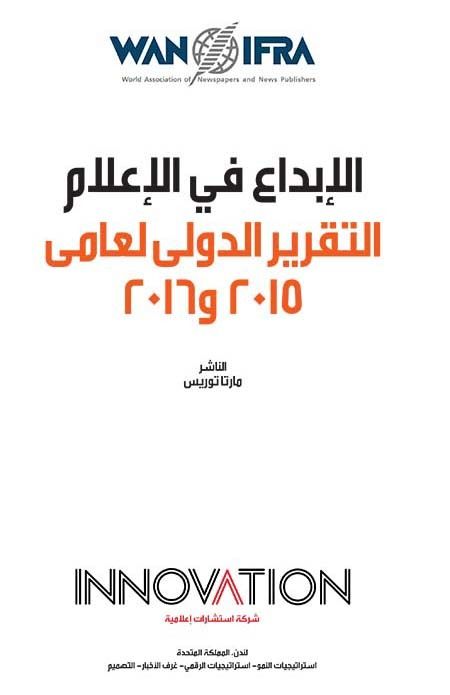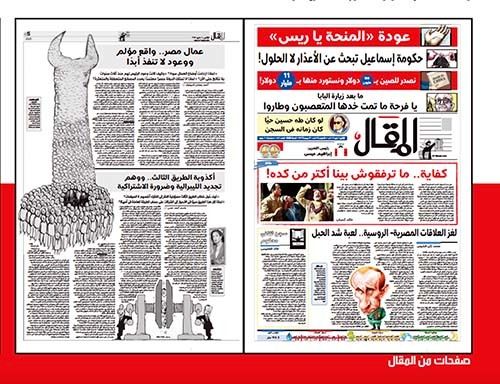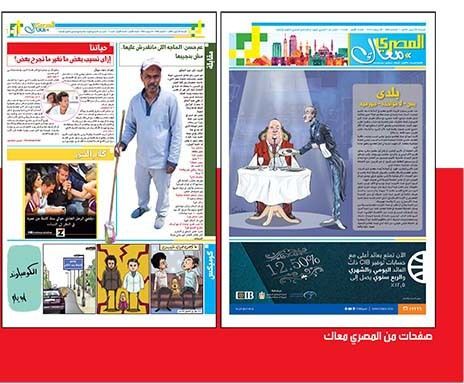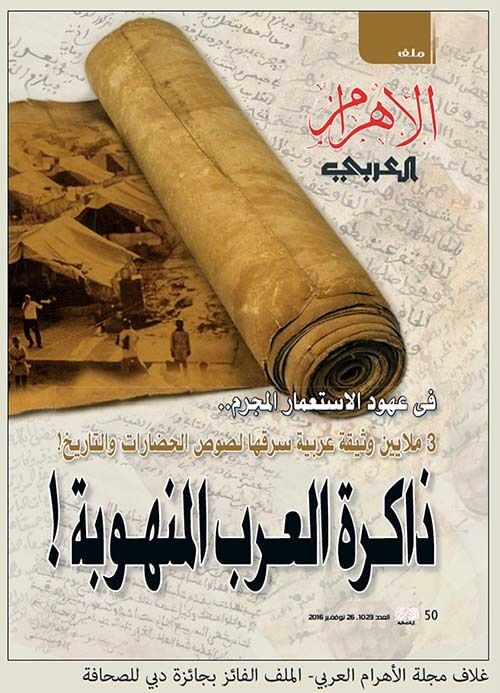Innovation in Arab media has seesawed in recent years but efforts are underway to stay apace of technological and editorial changes worldwide amid overall uncertainty about revenue streams and business models.
To help explain it, the Egypt Media Development Program (EMDP), the Egyptian Editors Forum (EEF), the Innovation Media Consulting Group and the World Association of Newspapers and News Publishers (WAN-IFRA) updated the Arabic edition of an invaluable annual publication that surveys the media landscape.

Arabic Innovation in Media Report (courtesy Innovation Media Consulting Group)
Two interesting experiments worth examining on the Egyptian scene: the first opted to sell its digital content to an audience used to consuming free digital news, and the second decided to distribute its print content free of charge to an audience accustomed to buying it. Two experiments at opposite ends of the spectrum but with a common denominator: innovation meant to present relatively new concepts to the Egyptian and Arab journalism industry. The first is “Al Maqal” (The Article), the first Egyptian newspaper to introduce a paywall for its digital content. The second is a new paper whose second issue coincides with publication of this report and is entitled “El Masri Maak” (The Egyptian With You) and which is considered the biggest experiment in free journalism in Egypt and the region.
That according to “Innovation in Media: The Annual International Report 2015-2016.”
While also using examples from its English-language mother editions for those two years that I reviewed at the time, it remains an insightful report on what works, what doesn’t, and how to remedy the situation in Arab media.
“Al Maqal,” founded in 2015, was a trailblazer in that it shunned the breaking and hot news of the day to focus on opinion and analysis rather than the usual mix of news, views, and entertainment, thereby setting a precedent as the first non-news daily in Egypt.

Pages from "Al Maqal" (courtesy Innovation Media Consulting Group)
Another innovative element was the introduction of colloquial Egyptian Arabic in the text when most media used/use standard classical Arabic in news delivery in print, broadcast and online media.
It bet on being able to attract a niche audience for its exclusive content although the initial sale price doubled when the Egyptian pound dropped in value, but it made up for it with attractive visuals - photos, illustrations, caricatures and infographics.
“El Masri Maak” flipped the business model with its free hand-to-hand distribution of a tabloid in specific locations on weekends by relying on advertisers targeting those areas’ news consumers.

"El Masry Maak" (courtesy Innovation Media Consulting Group)
Other experiments in hyperlocal news have emerged and disappeared in Egypt but they at least offered something different from the country’s tradition-bound legacy media.
According to EMDP director Tarek Atia, several individual and organizational innovations have emerged in the Arab world despite setbacks such as sliding investments, declining advertising revenues, and the crisis print media face from digital competition.
“Enterprise: The State of the Nation” is an English-Arabic email case study he likened to a “private club” drawing increasingly more members.

Tarek Atia (courtesy EEF)
“Enterprise” describes itself as “a daily subscription-only roundup of news and trends that will move markets and set the corporate agenda in Egypt, delivered Sunday through Thursday before 7am via email. Our readers are primarily C-suite executives, directors, senior managers, entrepreneurs, non-execs, investment relations officers, researchers and analysts.”
It also publishes a weekend edition on Friday. Egypt’s weekend is Friday and Saturday.
“Although it focuses primarily on economic news, to service its original business readers, it further seeks to help lay people understand Egypt’s international relations by shedding light on what international media publish about Egypt,” wrote Atia in the report. “It also summarizes key discussions on talk shows from the previous night.”
“Al Ahram Al Arabi” magazine is another example the report cites for having expanded its reach from Egypt to the Arab world through distinctive features and attractive visuals.

"Al Ahram Al Arabi" magazine cover (courtesy Media Innovation Media Group)
Its award-winning story on “The Arabs’ Looted Memory” highlights how heritage and history thieves had stolen three million Arab documents during colonial times.
Despite the positive innovation steps, media trainer Khaled Al Birmawy pointed to challenges facing Arab media, most notably the human resource angle.
“The problem starts with planning, determining goals and hiring, as one rarely finds an Arab media organization with a clear ‘hiring plan’, and most hiring operations are based on fuzzy personal visions, rushed needs and unclear duties/responsibilities,” he said.
Another key setback is the lack of importance given to regular training as in yearly programs to upgrade skills based on future plans, he added.
“Training must have an announced strategy, a defined budget, and clear ‘smart’ goals, gentlemen: it’s time for Arab media institutions to take training seriously,” he said.
A requirement for innovation is providing more space for experimentation and creativity in newsrooms as well as envisioning new ways of storytelling and engagement with content across platforms, which requires a “rethink” by editors and providing designers and developers major seats at the table, Al Birmawy wrote.

Screen shot of Egyptian Editors Forum launch
Conspicuously absent from the Arab-focused segment of the report is reference to the importance of mobile-first and the primacy of video in the mix, to say nothing of augmented, virtual and mixed reality.
Enter the Egyptian Editors Forum, an industry body grouping leaders to discuss issues facing the country’s media.
“EFF’s first and only priority is the importance of raising the level of the professionalism and innovation in the media,” the group says on its website, adding that its products and services include a weekly newsletter translating global best practices into relevant, and actionable advice for Arabic-speaking editorial and media leaders.
The Arabic Innovation report sells for $25 plus shipping – $20 plus shipping for bulk orders of 10 or more copies - and can be ordered via this link.
